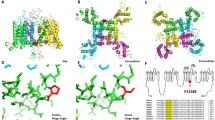Abstract
Ion channels are transmembrane proteins that allow ions to flow in or out of the cell. Sodium and potassium channel activation and inactivation are the basis of action potential’s production and conduction. During the past 15 years, ion channels have been implicated in diseases that have come to be known as the channelopathies. Over 30 mutations of the muscle channel gene SCN4A, which encodes the muscle voltage-gated sodium channel, have been described and associated with neuromuscular disorders like hypo- and hyper-kalaemic periodic paralyses (hypoPP and hyperPP), paramyotonia congenita, sodium channel myotonias and congenital myasthenic syndrome. Different mutations within the same gene (SCN4A) cause distinct clinical disorders, while mutations in different channel genes may result in similar phenotypes. In addition, identical sodium channel mutations can result in different clinical phenotypes (hyperPP or paramyotonia) in different members of the same family, suggesting that the genetic background and perhaps other epigenetic factors may influence the clinical expression of a particular mutation. This article reviews the clinical features of the skeletal muscle sodium channel diseases and highlights the phenotypic or genetic overlap in these disorders.
Similar content being viewed by others
Author information
Authors and Affiliations
Corresponding author
Rights and permissions
About this article
Cite this article
Vicart, S., Sternberg, D., Fontaine, B. et al. Human skeletal muscle sodium channelopathies. Neurol Sci 26, 194–202 (2005). https://doi.org/10.1007/s10072-005-0461-x
Received:
Accepted:
Issue Date:
DOI: https://doi.org/10.1007/s10072-005-0461-x




